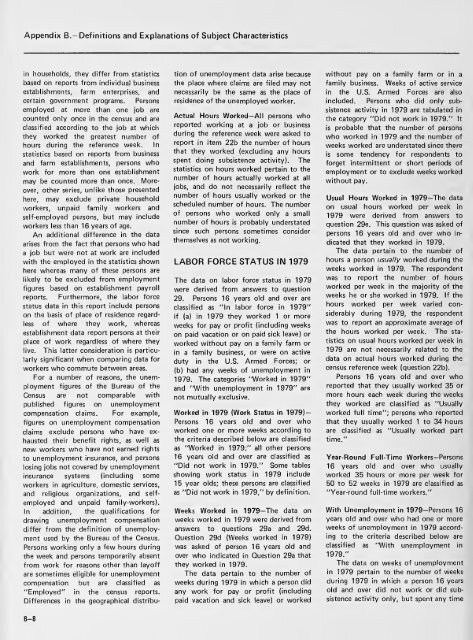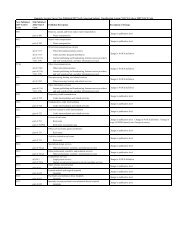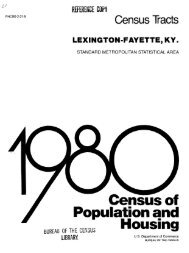1980 census of population. Characteristics of the ... - Census Bureau
1980 census of population. Characteristics of the ... - Census Bureau
1980 census of population. Characteristics of the ... - Census Bureau
You also want an ePaper? Increase the reach of your titles
YUMPU automatically turns print PDFs into web optimized ePapers that Google loves.
Appendix B.— Definitions and Explanations <strong>of</strong> Subject <strong>Characteristics</strong><br />
in households, <strong>the</strong>y differ from statistics<br />
based on reports from individual business<br />
establishments, farm enterprises, and<br />
certain government programs. Persons<br />
employed at more than one job are<br />
counted only once in <strong>the</strong> <strong>census</strong> and are<br />
classified according to <strong>the</strong> job at which<br />
<strong>the</strong>y worked <strong>the</strong> greatest number <strong>of</strong><br />
hours during <strong>the</strong> reference week. In<br />
statistics based on reports from business<br />
and farm establishments, persons who<br />
work for more than one establishment<br />
may be counted more than once. More-<br />
over, o<strong>the</strong>r series, unlike those presented<br />
here, may exclude private household<br />
workers, unpaid family workers and<br />
self-employed persons, but may include<br />
workers less than 16 years <strong>of</strong> age.<br />
An additional difference in <strong>the</strong> data<br />
arises from <strong>the</strong> fact that persons who had<br />
a job but were not at work are included<br />
with <strong>the</strong> employed in <strong>the</strong> statistics shown<br />
here whereas many <strong>of</strong> <strong>the</strong>se persons are<br />
likely to be excluded from employment<br />
figures based on establishment payroll<br />
reports. Fur<strong>the</strong>rmore, <strong>the</strong> labor force<br />
status data in this report include persons<br />
on <strong>the</strong> basis <strong>of</strong> place <strong>of</strong> residence regard-<br />
less <strong>of</strong> where <strong>the</strong>y work, whereas<br />
establishment data report persons at <strong>the</strong>ir<br />
place <strong>of</strong> work regardless <strong>of</strong> where <strong>the</strong>y<br />
live. This latter consideration is particu-<br />
larly significant when comparing data for<br />
workers who commute between areas.<br />
For a number <strong>of</strong> reasons, <strong>the</strong> unemployment<br />
figures <strong>of</strong> <strong>the</strong> <strong>Bureau</strong> <strong>of</strong> <strong>the</strong><br />
<strong>Census</strong> are not comparable with<br />
published figures on unemployment<br />
compensation claims. For example,<br />
figures on unemployment compensation<br />
claims exclude persons who have ex-<br />
hausted <strong>the</strong>ir benefit rights, as well as<br />
new workers who have not earned rights<br />
to unemployment insurance, and persons<br />
losing jobs not covered by unemployment<br />
insurance systems (including some<br />
workers in agriculture, domestic services,<br />
and religious organizations, and selfemployed<br />
and unpaid family-workers).<br />
In addition, <strong>the</strong> qualifications for<br />
drawing unemployment compensation<br />
differ from <strong>the</strong> definition <strong>of</strong> unemployment<br />
used by <strong>the</strong> <strong>Bureau</strong> <strong>of</strong> <strong>the</strong> <strong>Census</strong>.<br />
Persons working only a few hours during<br />
<strong>the</strong> week and persons temporarily absent<br />
from work for reasons o<strong>the</strong>r than lay<strong>of</strong>f<br />
are sometimes eligible for unemployment<br />
compensation but are classified as<br />
"Employed" in <strong>the</strong> <strong>census</strong> reports.<br />
Differences in <strong>the</strong> geographical distribu-<br />
B-8<br />
tion <strong>of</strong> unemployment data arise because<br />
<strong>the</strong> place where claims are filed may not<br />
necessarily be <strong>the</strong> same as <strong>the</strong> place <strong>of</strong><br />
residence <strong>of</strong> <strong>the</strong> unemployed worker.<br />
Actual Hours Worked— All persons who<br />
reported working at a job or business<br />
during <strong>the</strong> reference week were asked to<br />
report in item 22b <strong>the</strong> number <strong>of</strong> hours<br />
that <strong>the</strong>y worked (excluding any hours<br />
spent doing subsistence activity). The<br />
statistics on hours worked pertain to <strong>the</strong><br />
number <strong>of</strong> hours actually worked at all<br />
jobs, and do not necessarily reflect <strong>the</strong><br />
number <strong>of</strong> hours usually worked or <strong>the</strong><br />
scheduled number <strong>of</strong> hours. The number<br />
<strong>of</strong> persons who worked only a small<br />
number <strong>of</strong> hours is probably understated<br />
since such persons sometimes consider<br />
<strong>the</strong>mselves as not working.<br />
LABOR FORCE STATUS IN 1979<br />
The data on labor force status in 1979<br />
were derived from answers to question<br />
29. Persons 16 years old and over are<br />
classified as "In labor force in 1979"<br />
if (a) in 1979 <strong>the</strong>y worked 1 or more<br />
weeks for pay or pr<strong>of</strong>it (including weeks<br />
on paid vacation or on paid sick leave) or<br />
worked without pay on a family farm or<br />
in a family business, or were on active<br />
duty in <strong>the</strong> U.S. Armed Forces; or<br />
(b) had any weeks <strong>of</strong> unemployment in<br />
1979. The categories "Worked in 1979"<br />
and "With unemployment in 1979" are<br />
not mutually exclusive.<br />
Worked in 1979 (Work Status in 1979)-<br />
Persons 16 years old and over who<br />
worked one or more weeks according to<br />
<strong>the</strong> criteria described below are classified<br />
as "Worked in 1979;" all o<strong>the</strong>r persons<br />
16 years old and over are classified as<br />
"Did not work in 1979." Some tables<br />
showing work status in 1979 include<br />
15 year olds; <strong>the</strong>se persons are classified<br />
as "Did not work in 1979," by definition.<br />
Weeks Worked in 1979-The data on<br />
weeks worked in 1979 were derived from<br />
answers to questions 29a and 29d.<br />
Question 29d (Weeks worked in 1979)<br />
was asked <strong>of</strong> person 16 years old and<br />
over who indicated in Question 29a that<br />
<strong>the</strong>y worked in 1979.<br />
The data pertain to <strong>the</strong> number <strong>of</strong><br />
weeks during 1979 in which a person did<br />
any work for pay or pr<strong>of</strong>it (including<br />
paid vacation and sick leave) or worked<br />
without pay on a family farm or in a<br />
family business. Weeks <strong>of</strong> active service<br />
in <strong>the</strong> U.S. Armed Forces are also<br />
included. Persons who did only sub-<br />
sistence activity in 1979 are tabulated in<br />
<strong>the</strong> category "Did not work in 1979." It<br />
is probable that <strong>the</strong> number <strong>of</strong> persons<br />
who worked in 1979 and <strong>the</strong> number <strong>of</strong><br />
weeks worked are understated since <strong>the</strong>re<br />
is some tendency for respondents to<br />
forget intermittent or short periods <strong>of</strong><br />
employment or to exclude weeks worked<br />
without pay.<br />
Usual Hours Worked in 1979-The data<br />
on usual hours worked per week in<br />
1979 were derived from answers to<br />
question 29e. This question was asked <strong>of</strong><br />
persons 16 years old and over who in-<br />
dicated that <strong>the</strong>y worked in 1979.<br />
The data pertain to <strong>the</strong> number <strong>of</strong><br />
hours a person usually worked during <strong>the</strong><br />
weeks worked in 1979. The respondent<br />
was to report <strong>the</strong> number <strong>of</strong> hours<br />
worked per week in <strong>the</strong> majority <strong>of</strong> <strong>the</strong><br />
weeks he or she worked in 1979. If <strong>the</strong><br />
hours worked per week varied con-<br />
siderably during 1979, <strong>the</strong> respondent<br />
was to report an approximate average <strong>of</strong><br />
<strong>the</strong> hours worked per week. The sta-<br />
tistics on usual hours worked per week in<br />
1979 are not necessarily related to <strong>the</strong><br />
data on actual hours worked during <strong>the</strong><br />
<strong>census</strong> reference week (question 22b).<br />
Persons 16 years old and over who<br />
reported that <strong>the</strong>y usually worked 35 or<br />
more hours each week during <strong>the</strong> weeks<br />
<strong>the</strong>y worked are classified as "Usually<br />
worked full time"; persons who reported<br />
that <strong>the</strong>y usually worked 1 to 34 hours<br />
are classified as "Usually worked part<br />
time."<br />
Year-Round Full-Time Workers— Persons<br />
16 years old and over who usually<br />
worked 35 hours or more per week for<br />
50 to 52 weeks in 1979 are classified as<br />
"Year-round full-time workers."<br />
With Unemployment in 1979— Persons 16<br />
years old and over who had one or more<br />
weeks <strong>of</strong> unemployment in 1979 accord-<br />
ing to <strong>the</strong> criteria described below are<br />
classified as "With unemployment in<br />
1979."<br />
The data on weeks <strong>of</strong> unemployment<br />
in 1979 pertain to <strong>the</strong> number <strong>of</strong> weeks<br />
during 1979 in which a person 16 years<br />
old and over did not work or did sub-<br />
sistence activity only, but spent any time





